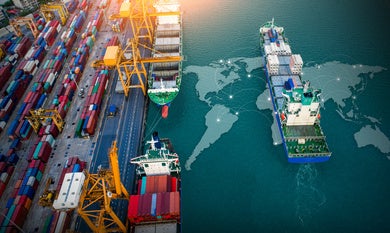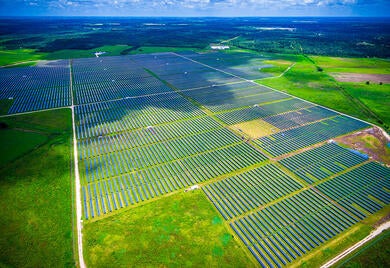
How Trade Finance Boosts Access to Credit for Smaller Businesses and Food Security
Most of the world’s commerce depends on trade finance. However, the global trade finance gap surged to an estimated $2.5 trillion in 2022, widened by the pandemic and ongoing economic and geopolitical uncertainty. Narrowing this gap can have a positive impact on two pressing challenges facing the region: limited access to finance for SMEs and mounting food insecurity.

Pioneering climate fund shows us what real transformations can look like
The dry wind and unrelenting sun left one uncomfortably exposed. The wafer thin air challenged every breath and made each step feel like my legs were encased in lead. Yet the journey into this Martian landscape disturbed by volcanoes in Chile’s Atacama Desert was well-worth it. South America’s first, and the highest of its kind at 4500 meters above sea level, the Cerro Pabellón geothermal project, with an installed capacity of 48 MW, is a remarkable achievement. Developed by ENEL Green Power and Chile’s Empresa Nacional del Petróleo with financial support from the Inter-American Development Bank (IDB) and the Climate Investment Funds (CIF), which I helped to design 10 years ago, the visit was especially poignant for me. The trip to Cerro Pabellón in 2018 is part of the CIF@10 campaign marking the 10-year anniversary of the creation of the Climate Investment Funds, which culminated this week at Morocco’s Noor Concentrated Solar Panel complex. Trust and big goals An example of a truly sustainable infrastructure project, Cerro Pabellón employs over 1000 people and produces electricity to power more than 165,000 households, while avoiding over 166,000 tons of CO2 emissions each year. The development of the project involved several indigenous communities and the nearby town of Ollagüe also benefitted following the provision of 24 hour electricity, which the mayor said drastically improved the lives of residents. Cerro Pabellón powerfully demonstrates how the CIFs have helped to accelerate low carbon and climate resilient transformations. Implemented by Multilateral Development Banks, the CIFs provide developing countries with grants, concessional loans, risk mitigation instruments, and equity that leverage financing from the private sector and banks. Since 2008, US$ 8 billion has been pledged with more than 300 projects or programs funded in 72 developing countries to promote clean technology, energy access, climate resilience and sustainable forests. The CIF’s Clean Technology Fund (CTF) made the first real contributions to kick-starting renewable energy markets in many developing countries. With initial support from CTF and other concessional resources, Chile’s performance on renewable energy has skyrocketed. From 2014 through 2017, Chile built 973MW of wind and 1.9GW of solar to become Latin America’s third largest clean energy market. Representing $10 billion of clean energy investment from 2013-2017, Chile was ranked first among developing countries in 2018 for its ability to attract investment. This progress has boosted confidence in the potential of renewable energy to meet electricity demand and to position Chile as a global leader on climate change across different government administrations. Building on his predecessor’s legacy, Chilean President Sebastián Piñera has proposed a target of generating 100% electricity from renewable energy by 2040, starting an ambitious plan for decarbonization of the energy matrix. As we think about how to shift the trillions of dollars necessary to deliver on the Paris Agreement and the Sustainable Development Goals, it is essential to build on the lessons learnt and capacity developed from 10 years of experience with the CIFs. Incorporating a new approach The fund’s projects go beyond reducing emissions by improving lives and kick-starting systemic change to build low carbon and climate-resilient economies. Building confidence with government and the private sector and advancing regulatory changes and improving institutional capacity are CIF hallmarks. CIF projects have proved successful when multilateral development banks are able to combine expertise and governments have a clear sectoral plan supported by communities, finance and industry. The deployment of technical cooperation to prepare projects to address non-financial barriers has also proved paramount for success. As we think about the next decade it’s crucial to build on the CIF’s experience by continuing to work in a programmatic way on key sectors and ensure the scale of finance and resources for institutional strengthening is capable of delivering transformational impact, maintain incentives to work on more innovative projects and flexibly apply financial instruments to deliver greatest impact and mobilize markets effectively. As Chile’s Cerro Pabellón shows, the road to the summit is steep. But we can make it. The lessons learnt from the CIF offer a springboard to do just that. ■ LEARN HOW IDB INVEST CAN OFFER YOU SOLUTIONS HERE. SUBSCRIBE AND RECEIVE RELATED CONTENT [mc4wp_form]

Three ways banks can attract millennials
71% of the millennials in the United States would rather go to the dentist than listen to what banks are saying, according to the Millennial Disruption Index, while 35% of the banks in Latin America feel they are not meeting the needs of this generation, and 71% admit they are unable to rapidly adapt to technological advances, according to a study done by the GMix program of Stanford University and Technisys. However, in upcoming years this age group will be the main source of consumers and labor. Millennials represent close to 30% of the population in Latin America and the Caribbean. For more than half of them, only innovative companies will be successful. In effect, four out of every ten believe that the private sector is the true driver of innovation, according to a survey conducted by Deloitte. For this reason, banks in the region are looking for new formulas to attract them: 1. Chile: Collaborative spaces The millennials are the “BRICs” of the age groups: due to their size, they can disrupt the economy, particularly the banking industry, according to Scratch. In Chile, banks are betting on collaborative spaces to approach this generation. Thus, was born Work/Café, a space open to the general public for working, holding meetings, and using free Wi-Fi and that already has six locations in the country. The Santander Group’s wager includes a cafeteria with discounts for clients, executives specializing in financial advice, and ATMs for cashing checks, making deposits, and transferring funds. Another characteristic sought by millennials is flexibility. Thus, these branches add four hours to traditional banking hours in Chile, remaining open for 18 hours, Monday through Thursday. Work/Café also gives talks in order to keep capturing clients constantly. [clickToTweet tweet="35% of the banks in #Latam feel they are not meeting the needs of the millennials" quote="35% of the banks in Latin America feel they are not meeting the needs of the millennials" theme="style1"] 2. Brazil: 100% virtual In Latin America and the Caribbean, 55% of the population buys products via the Internet and 90% of millennials are digital banking clients. For this reason, a Brazilian bank made the decision to be the first 100% digital bank. Banco Original developed a website, applications for mobile telephones, tablets, and even Smart TVs to reach its public on line and close its branches. To avoid in-person visits, this Brazilian bank developed a site with services for personal, commercial, and agribusiness banking. In addition, it developed Bot Original, a service enabling interactions via Messenger and even on Facebook, with a robotic system of instantaneous responses for clients. 3. Mexico: On-line support for SMEs One of the region’s largest financing gaps is experienced by small and medium enterprises (SMEs); this gap is estimated at between $210 billion and $250 billion. However, for more than half of the region’s millennials, a venture is one of the most important achievements. Thus, the banking system is seeking ways to facilitate access to financing for SMEs given that applications for financing for companies of this type still require in-person visits in many countries. Bankaool, Mexico’s first 100% on-line bank, developed financing tools for SMEs. Clients can apply for and receive financing for their businesses in a more streamlined and expeditious way. This has also allowed the bank to carve out a niche within the financial industry based on its work generating inclusive businesses. Innovative wagers continue to flourish in the region and in the rest of the world, from applications for different financial operations and the use of biometric profiles, to the development of products for women’s banking. They all seek a positive effect on returns, efficiency, and the consumer’s experience. It is thus essential to continue looking for strategies that make attracting millennials possible since, as John D. Wright once said, “Business is like riding a bicycle. Either you keep moving or you fall down.” Now we need to see what the banking sector’s next move will be in the region. Subscribe to receive more content like this! [mc4wp_form]

Four countries leading in solar in Latin America and the Caribbean
Nearly half of the global electric power capacity could come from solar energy by 2025, according to McKinsey & Company. Multiple Latin American and Caribbean countries, benefitting from exceptional resources and evolved regulatory frameworks, have seen rapid growth in solar energy in the last few years. Utility scale projects are now considered commercially viable and receive private financing, while the application of distributed solar is growing quickly. However, falling solar prices are squeezing the industry, and macroeconomic uncertainty will continue to test its strength. Meanwhile, developers are now consolidating to gain market share and achieve profitability.

New ways to increase infrastructure investment
Historically, Latin America has invested 2% to 3% of regional gross domestic product (GDP) per year in infrastructure, even though it should reach at least 5% to meet the region’s needs. This difference creates a gap so large that can only be reduced with both private and public investments participation. What progress has been made to close this gap? Colombia and Chile are the countries with the highest capacity to carry out sustainable Public Private Partnerships (PPPs) in infrastructure in the region, according to the Infrascope. Chile has a long tradition of private participation in infrastructure projects that goes back 25 years. Also, it has a sound regulatory framework supporting PPPs, a solid investment and business climate, and has developed financing instruments. Colombia also enjoys a strong regulatory framework, supported particularly by the 2012 PPP law, and the strength of the institutions in charge of developing and maintaining PPP contracts. In the past five years, Chile and Colombia have awarded 70 and 30 PPP projects, respectively. What can we learn from these countries’ experiences? Colombia and Chile are two examples for the rest of region, especially regarding its regulations and PPPs' maturity, where both countries scored first in the ranking for these two Infrascope’s assessment categories. Colombia, for example, has incorporated the lessons learned from preceding toll road concession programs in the current 4G framework, particularly in the areas of: 1) risk allocation; 2) contracts financial structuring; 3) standardization of technical studies, financial models and methodologies to value risk; 4) streamlining and standardization of contracts; and 5) improvement of bankability, through the inclusion of lenders’ step-in rights and dispute resolution provisions; among others, according to a recent report from the Inter-American Development Bank (IDB). [clickToTweet tweet="Latin America needs to invest 5% of its GDP in infrastructure per year" quote="Latin America needs to invest 5% of its gross domestic product (GDP) in infrastructure per year" theme="style1"] However, while the progress is important, there are challenges that remain, particularly, in mobilizing financing for the already awarded projects. Until now only eight projects have achieved financial closings for approximately $4 billion and there are still $10 billion remaining to finance. The lessons and challenges from the 4G road concession program in Colombia are not unique to this sector, other infrastructure areas face similar constraints when it comes to accessing financing. It is no coincidence that the Infrascope’s Financing category yields the lowest score of the five assessment criteria for the 23 countries analyzed, with an average of 45 over 100. Moreover, when it comes to developing innovative financing solutions, such as mobilizing institutional investors to close the infrastructure investment gap, even countries like Chile, still faces some challenges. In this country, the local regulations do not allow private pension funds to directly finance infrastructure projects. How to help the region bridge the infrastructure financing gap? To bridge this gap there are common features in place that are working. For example, countries like Brazil, Chile and Peru, that are ranked the highest in the Infrascope’s financing category, share the common feature of having some of the most developed capital markets in the region, with freely traded local-currency bonds from public and private issuers, as well as low sovereign risk. Another example is Colombia and its work to address this gap through institutions like the Financiera de Desarrollo Nacional (FDN). This entity develops innovative financial products to reduce the financing costs for the projects and to facilitate access to finance and to capital markets, through credit guarantees and senior and subordinated debt with long tenors. Recently, the FDN launched a new product consisting of local currency loans to attract international investors that can provide guarantees and take the credit risk in the exposures but prefer to avoid the exchange rate risk. [clickToTweet tweet="Issuing impact development bonds and green bonds is key to increase infrastructure investments" quote="Issuing impact development bonds and green bonds is key to increase infrastructure investments" theme="style1"] The lessons learned so far highlight areas that need to advance such as: 1) opening up the markets to local institutional lenders (i.e. private pension funds and insurance companies); 2) issuing impact development bonds and green bonds; 3) promoting access to project development funds; and 4) facilitating innovation with more sophisticated products in the financial sector and capital markets. The debentures guarantee of Santa Vittoria do Palmar in Brazil and the B-bond for Campo Palomas in Uruguay, both structured by IDB Invest (formerly known as Inter-American Investment Corporation) show that the role of the private sector arms of multilateral development banks continues to be very relevant. These projects underscore the value of delivering innovative financing solutions and partnering with key public and private stakeholders to close the infrastructure financing gap in the region. Subscribe to receive more content like this! [mc4wp_form]

What powers Chile's energy transformation?
Recently The New York Times highlighted Chile’s energy transformation. The profile told the story of Chile’s clean energy market revolution. However, missing from the story was one key component that facilitated Chile’s sustainable energy surge: donor funds. Donor funds supported by governments can lower cost and risk barriers, which limit financing for renewable energy projects. Donor funds invest in untested technologies and new markets, while also adhering to the highest social and environmental standards. Their purpose is to jumpstart climate-friendly investments in developing countries. In 2008, Chile had less than 20 megawatts (MW) of installed non-conventional renewable energy (NCRE), such as wind, solar and geothermal. The government’s Energy 2050 law set a target to increase Chile’s share of renewable energy to at least 60% by 2035. Despite developers’ enthusiasm for Chile’s stable political environment and resource endowment, which includes over 300 days of sunshine per year in the Atacama Desert, local banks had little or no experience with NCRE technologies. Donor funds: able to overcome cost and risk barriers But with access to donor funds, other organisms, such as multilaterals can deploy financial structures that overcome certain cost and risk barriers, making projects feasible for developers. Funds like the Clean Technology Fund (CTF) and the Canadian Climate Fund for the Private Sector in the Americas (C2F) allow us to “blend” our capital and ultimately take more risks. For example, in 2013, IDB Invest (formerly known as Inter-American Investment Corporation) used a C2F loan plus our own financing for Pozo Almonte and Calama Solar, Latin America’s first large-scale photovoltaic plants. The Chilean market evolved rapidly. By 2014, the Crucero solar project, which IDB Invest also financed, piqued the interest of a commercial bank. Soon commercial banks fully financed hundreds of megawatts of NCRE. Today, solar photovoltaic in Chile no longer needs donor money. Thanks in large part to donor funds, IDB Invest financed five photovoltaic projects in Chile and recently completed our first wind project, contributing to Chile’s 3,400 MW of NCRE. A recent Inspiratia article, which covered the Aela wind farm, recognized, “for Aela, the [IDB Invest] involvement was key, not only from a ticket size perspective, but also in helping the commercial banks get comfortable with the transaction. In the Cerro Pabellon geothermal plant, by channeling resources from the CTF, for which IDB Invest is the implementing entity, IDB Invest provided an insurance-like financial instrument to Enel Green Power to offset the high cost and risk associated with exploratory geothermal drilling — a risk most commercial lenders and insurance providers are typically unwilling to take. Development banks are one of the few players positioned to test first-mover risks and provide long-term tenors; however, it is the donor funds that are perhaps the unsung heroes of Chile’s energy transformation. Market forces taking over where donor funds left off is a trend that transcends Chile. Uruguay, Costa Rica and now El Salvador have all contributed to Latin America’s renewable surge which is 53% of total energy generation compared to the 22% world average. Back in Chile, the lure of cleaner, commercially-viable energy is now attracting the next generation of industry. Companies like Amazon and Alphabet Inc.’s Google would like to set up data centers powered by this renewable energy. These firms create jobs and offer training to the Chilean workforce. And so the renewable energy story continues. Subscribe to receive more content like this! [mc4wp_form]